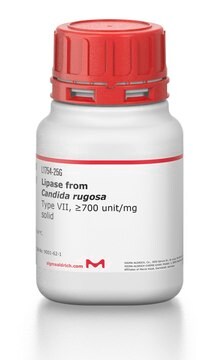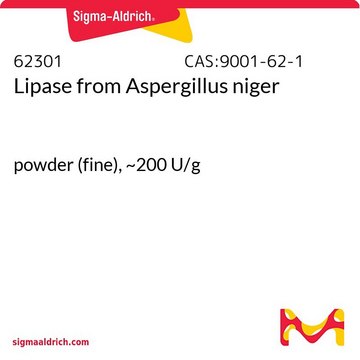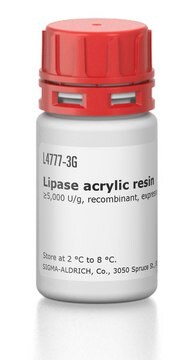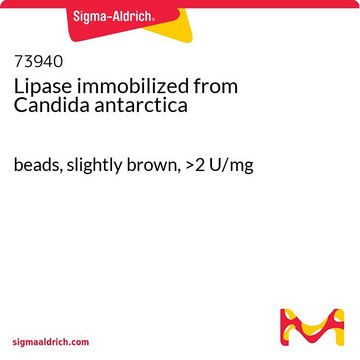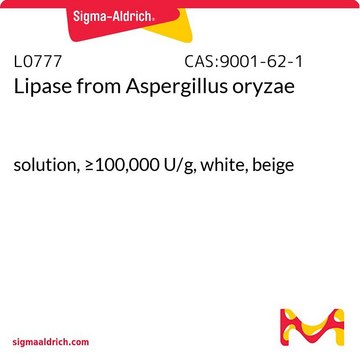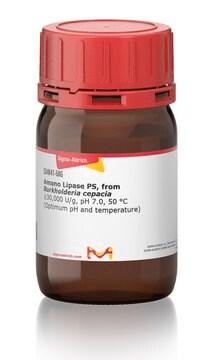Wszystkie zdjęcia(1)
Kluczowe dokumenty
62287
Lipase A Candida antarctica, recombinant from Aspergillus oryzae
powder, beige, ~2 U/mg
Zaloguj sięWyświetlanie cen organizacyjnych i kontraktowych
About This Item
Polecane produkty
rekombinowane
expressed in Aspergillus oryzae
Poziom jakości
Postać
powder
aktywność właściwa
~2 U/mg
okres trwałości
limited shelf life, expiry date on the label
kolor
beige
temp. przechowywania
2-8°C
InChI
1S/C11H9N3O2.Na/c15-8-4-5-9(10(16)7-8)13-14-11-3-1-2-6-12-11;/h1-7,16H,(H,12,14);/q;+1/b13-9-;
Klucz InChI
QWZUIMCIEOCSJF-CHHCPSLASA-N
Szukasz podobnych produktów? Odwiedź Przewodnik dotyczący porównywania produktów
Opis ogólny
Lipase A Candida antarctica (CALA) belongs to the α/β hydrolase family. The catalytic triad comprises Ser184, His366, and Asp334 residues.
Zastosowanie
Lipase A Candida antarctica, recombinant from Aspergillus oryzae has been used in the enzyme-catalyzed hydrolysis studies with 3-acetylthiohexanal. It has also been used as a biocatalyst to test its effect on the esterification of phytosterol with caprylic acid.
Działania biochem./fizjol.
Lipase A Candida antarctica (CALA) is a thermostable serine hydrolase with a higher sn-2 preference towards triglycerides. It displays excellent activity towards large substrates as well as bulky sterically hindered tertiary alcohols.
Lipase A from Candida Antarctica catalyzes hydrolysis of tertiary alcohols to form glycerol and fatty acids and shows selectivity for the N-acylation of β-amino esters.
Definicja jednostki
1 U corresponds to the amount of enzyme which liberates 1 μmol oleic acid per minute at pH 8.0 and 40°C (triolein, Cat. No. 62314, as substrate); 1 U as described above is equivalent to ~0.15 U using trybutyrine, Cat. No. 91010, as substrate, at pH 8.0 and 70°C
Inne uwagi
Characterization
Ta strona może zawierać tekst przetłumaczony maszynowo.
zastąpiony przez
Numer produktu
Opis
Cennik
Hasło ostrzegawcze
Danger
Zwroty wskazujące rodzaj zagrożenia
Zwroty wskazujące środki ostrożności
Klasyfikacja zagrożeń
Resp. Sens. 1
Kod klasy składowania
11 - Combustible Solids
Klasa zagrożenia wodnego (WGK)
WGK 1
Temperatura zapłonu (°F)
Not applicable
Temperatura zapłonu (°C)
Not applicable
Środki ochrony indywidualnej
Eyeshields, Gloves, type N95 (US)
Wybierz jedną z najnowszych wersji:
Masz już ten produkt?
Dokumenty związane z niedawno zakupionymi produktami zostały zamieszczone w Bibliotece dokumentów.
Klienci oglądali również te produkty
Biotechnological relevance of the lipase A from Candida antarctica
Monteiro RRC, et al.
Catalysis Today, 362, 141-154 (2021)
Anders G Sandström et al.
Protein engineering, design & selection : PEDS, 22(7), 413-420 (2009-06-11)
We herein report the first directed evolution of Candida antarctica lipase A (CalA), employing a combinatorial active-site saturation test (CAST). Wild-type CalA has a modest E-value of 5.1 in kinetic resolution of 4-nitrophenyl 2-methylheptanoate. Enzyme variants were expressed in Pichia
Integrated enzymatic production of specific structured lipid and phytosterol ester compositions
Hellner G, et al.
Process. Biochem., 45(8), 1245-1250 (2010)
S.A. Patkar et al.
Indian Journal of Chemistry, 76-76 (1993)
Hidehiko Wakabayashi et al.
Journal of agricultural and food chemistry, 51(15), 4349-4355 (2003-07-10)
The enantioselectivity of the generation of 3-mercaptohexanal and 3-mercaptohexanol, two potent sulfur-containing aroma compounds, by lipase-catalyzed hydrolysis of the corresponding 3-acetylthioesters was investigated. The stereochemical course of the kinetic resolutions was followed by capillary gas chromatography using modified cyclodextrins as
Nasz zespół naukowców ma doświadczenie we wszystkich obszarach badań, w tym w naukach przyrodniczych, materiałoznawstwie, syntezie chemicznej, chromatografii, analityce i wielu innych dziedzinach.
Skontaktuj się z zespołem ds. pomocy technicznej

